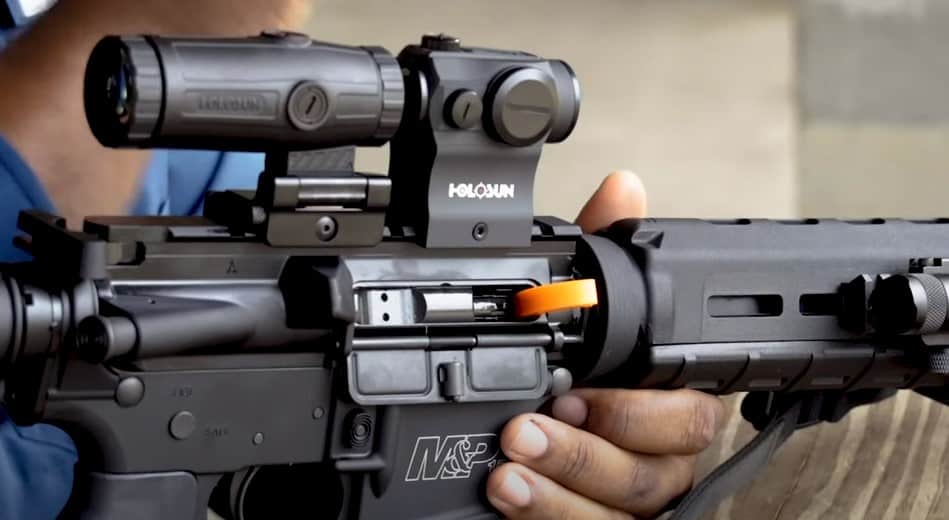How Modern Rifle Optics Have Improved Over The Years

Iron sights have gone the way of the dinosaurs. But do not get me wrong, the use of iron sights should still be a mandatory part of firearms training, and it’s completely possible to hit long-range targets with them if you know how.
The fact is, since the late 1970s, optics have been slowly edging out iron sights on the battlefield. Weapons like the Steyr AUG led the way in the implementation of optics for every soldier’s rifle, not just designated marksmen or snipers.
European nations were some of the first to adopt optics as a widespread military issue item widely. Going all the way back to World War two, the Germans even saw the advantage and topped their FG 42 with an integrated optic.
If you are considering a tactical optic, then you have an enormous market to choose from. Since the adoption of optics by the United States military, the market has exploded.
Since then, more and more shooters desire military-quality red-dot/holographic optics and see the overall advantage of having a tactical optic.
Modern Rifle Optics – Back to the Basics
It is mind-boggling to see how the scope technology has evolved during the first two decades of the 21st century. In today’s riflescope, the elevation and windage adjustments are more precise, and the optics are clearer.
Using it makes it possible to calculate the range at which a target can be hit at unimaginable distances. In addition, it is possible to recognize infrared signatures in complete darkness with the help of infrared scopes.
A sniper’s scope, once so big it required a separate carrying case, is now small enough to fit in a pants pocket, providing them with the edge to hit man-sized targets at nearly a thousand yards during. Entrepreneurs from the previous century laid the foundation for much of the technology of the 21st century.
For example, Swedish manufacturer Aimpoint introduced the concept of a low- to no-magnification sight with a red dot in the 1970s, which became popular on rifles, shotguns, and even handguns today. Later on, Trijicon introduced an Armson OEG sight with a red dot made from tritium.
Each company has developed durable, accurate, and repeatable sights from these humble beginnings for military, tactical, hunting, and competition applications. Sportsmen and the military have scoffed at optical gun sights for decades because they are too fragile.
The sights and their mounting systems have been significantly improved, even though anything attached to a firearm’s exterior is subject to being knocked off kilter-or even off the gun-during hunting or military activity.
Most Important Factors For Modern Tactical Optics
With a large market, it can be confusing to choose an optic. Having a little knowledge will help you make the right choice.
Durability
This is one of the most important factors in choosing a tactical optic and the ultimate reason to own a set of backup iron sights.
Optics, by nature, are somewhat fragile and often involve glass and some form of light admission in their design.
This being said, there is no reason an optic cannot be durable. An optic’s body should be made from high-quality aluminum.
Aircraft-grade aluminum is what makes the majority of high-quality optics like Aimpoint T-1 and Eotech 512. Tactical operations are often rough, messy, and violent. This is the simplest means of explaining that things are unpredictable.
A tactical optic should be able to meet certain expectations. These include being waterproof since one cannot control when it rains.
Also, an optic should be shockproof and capable of retaining zero after taking a bump or two, and a bump or two can be slamming your rifle into a wall, butt-stroking someone, or simply tripping and hitting the ground.
Mounting Method
A Weaver or Picatinny rail is the standard mounting system for most firearms accessories. Often an optic will be compatible with both since the rails systems are incredibly similar.
However, if you are using a nonstandard or exotic rifle, it may not have a Picatinny or weaver rail. Like the older AR series, other rifles may have a fixed carrying handle and no additional options for a rail to mount an optic.
The same goes for the AK series. Most will not feature a rail, and mounting on one the dust cover is often inaccurate due to the constant movement. Therefore, special considerations must be made to outfit these weapons with an optic.
Weapon Limitations
What weapons are you looking to put an optic on? Different weapons have different limitations and different advantages. For example, a good tactical shotgun can be an excellent close-quarters battle weapon.
That being said, it has range limitations. Therefore, there is no reason to equip a 4x Trijicon ACOG on the weapon. The same could be said for certain pistol caliber carbines, and submachine guns.
On the flip side, those operating an M4 style carbine or any rifle caliber carbine are missing out by equipping their weapon with a miniature red optic.
Miniature red dots are great optics but do not allow the rifle to reach its full potential. When equipping a weapon with an optic you need to understand it strengths and its weaknesses and equip the weapon accordingly.
The idea that any optic is better than no optic is a dangerous methodology. The wrong optic can hamper the weapon.
Reticle
Choosing a reticle should fit in with the intended use of the weapons and its limitations. For example, a shotgun is a simple weapon that can use a simple reticle. Anything by Aimpoint would be perfect for a shotgun.
At the same time, an Aimpoint works wonderfully on a carbine intended for close-range work. The simple red dot reticle lends itself well to close-range combat. Another thing to consider is a bullet drop compensator which Nikon, for example, uses even on their cheaper optics.
A bullet drop compensator allows the user to place longer-range shots with accuracy, without the need for the shooter to do the math required for bullet drop. For these bullet drop compensators to work, a number of conditions must be met.
These involve the barrel length, the bullet’s weight, and even how the optic is mounted. The Trijicon ACOG has dozens of different options for what appears to be the same optic.
But they are designed for weapons with different barrel lengths and around a certain bullet. Straying from this formula can disrupt the accuracy of the bullet drop compensator.
Power Source
Modern tactical optics often feature an illuminated reticle or an option for one. These reticles allow for ease of use regardless of the light provided and generally are more eye-catching. This is important when it comes to close quarters, rapidly moving firefights. Missing the reticle or not seeing it can be fatal.
Selecting a particular type of power source will be important when you consider your own logistics. For example, certain police departments may issue battery A, but your optic uses battery B. Of course, you can buy your own batteries as a police officer or everyday joe, but what if the battery isn’t sold locally?
You are forced to the internet, but is it pricey? You may consider using a different optic or inquiring if that optic has a model for your chosen power source.
If you want to stay away from batteries, you can go with models designed by Trijicon. These optics use a combination of tritium and fiber optics to absorb light and charge the illuminated reticle.
The only issue with these is the fact you cannot easily adjust the brightness level on these optics and have to rely on their auto-adjustment properties. The main appeal is that batteries are not needed.
Accessory Capability
Certain optics are compatible with a variety of different accessories, and some are not. These accessories can add to the overall efficiency of the weapon. These can include:
- Lasers
- Mounted miniature red dot sights
- Magnifiers
- Doublers
- Night vision devices
If night vision capability is something you desire, it’s important to know if your weapon is compatible. For example, the Eotech XPS2 is not night vision compatible but is magnifier compatible. Important things to know.
Another risk is mounting space. The ACOG series takes up more space than an Aimpoint on a rail, and this is something to consider with certain weapons. Some, like the MP5 or CETME series, have limited rail space, and fitting an ACOG and night vision device in that small space is impossible.
The Bottom Line
As the technology shrank and demand grew, tactical optics became a large market. A variety of different optics occupy nearly every price range imaginable, and the small nuances between optics present enough options to drive any consumer to stir crazy.
Recommendations can be made for dozens and dozens of different optics, but ultimately, it’s up to the user. However, as long as you understand the things listed in this guide, you can select a quality optic that fits your mission.

